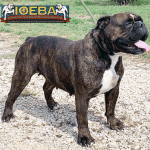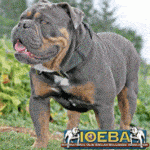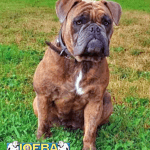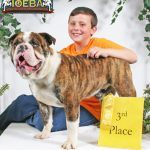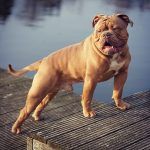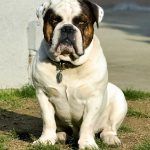Breed History
The ancestors of the Olde English Bulldogge originated in England between 1600 and 1700. These early Bulldogges were also the ancestors to many of the bull breeds that exist today including the English Bulldog and the American Bulldog.
The original Bulldogges were bred to participate in blood sports like bull baiting. This so called sport became quite popular in England throughout the middle of the 18th Century. Bull baiting primarily consisted of staking out a bull and allowing several Bulldogges to attack it. A dog of great courage and agility was needed for bull baiting. This dog was of medium size; larger dogs were considered to be the result of various mastiff crosses.
Around 1835, laws were passed in England prohibiting bull baiting and the original Bulldogges main purpose of existence vanished. Within a decade the numbers of Bulldogges declined drastically almost to the point of extinction. Dog show fanciers eventually decided to reconstruct the breed, but wanted to tone down the aggressive temperament of the original Bulldogge. To do so they crossed the remnants of the existing stock with other breeds and over the years that followed they developed the modern English Bulldog. Unfortunately though the majority of today’s modern English Bulldogs are wrought with all kinds of genetic health problems.
Today’s Olde English Bulldogge is a reconstruction of the original Bulldogge of the 17th and 18th century. Various genetic crosses have been used in carefully and thoughtfully planned breeding programs to obtain this goal. The foundation of most of today’s Olde English Bulldogges can be traced back to English Bulldogs, American Bulldogs, APBTs and Mastiffs. These various dog breeds were used very selectively in various combinations to obtain the desired physical traits of the original Bulldogge.
The result has been a good looking Bulldogge of great athletic ability that is much healthier and physically fit without most or all of the problems that plague many of today’s modern English Bulldogs. The goal of all Olde English Bulldogge breeders should be to produce genetically healthier Bulldogges that are free breathers, free breeders, and free whelpers.
Today it is recommended that the International Olde English Bulldogge Association’s Breed Standard be used by Olde English Bulldogge breeders in an effort to maintain the high standards that the breeders of the past and the International Olde English Bulldogge Association have set forth to continue to improve and preserve today’s Olde English Bulldogge for future generations of fanciers.
Breed Standard
The IOEBA’s official Olde English Bulldogge breed standard is a detailed written description of the perfect “type” or “flawless” Olde English Bulldogge.
A well written detailed breed standard is a very effective tool that should be used to assist breeders of Olde English Bulldogges in the selection process and evaluation of Olde English Bulldogges that are being considered for a structured breeding program or as a possible conformation show participants.
It is important that Olde English Bulldogge breeders understand and use the IOEBA’s official Olde English Bulldogge breed standard, as the offspring they produce will have an impact on the Olde English Bulldogge breed in the future for many generations.
The goal of all reputable Olde English Bulldogge breeders is to achieve perfection as far as correct breed type, health and temperament.
All IOEBA conformation judges use the IOEBA’s official Olde English Bulldogge breed standard as a guide to give themselves a mental picture of breed perfection by which they select future IOEBA conformation champions.
General Description : The ideal Olde English Bulldogge is a loyal, courageous dog of medium size with a large powerful head and stout muscular body. Olde English Bulldogges are athletic and most importantly of very good health, males are free breeders and females are free whelpers. The Olde English Bulldogge is devoid of all breathing issues and is capable of enjoying outdoor activity without concern except in extreme heat or cold. The temperament is very stable and trustworthy making them a loyal companion, capable protector and the ultimate family member. Olde English Bulldogges thrive on pleasing their owners and are very trainable. The typical lifespan of an Olde English Bulldogge is between 10 and 14 years.
Head : Large and high, moderately sunken between the eyes (medial furrow). The circumference of the head should be equal to or greater than the dog’s height at the shoulder. A narrow head or one that appears too small for the body is a fault.
Ears : Rose ears set well on the sides of the head are preferred. Dropped ears are acceptable as long they are small, not “hound like”. Full pricked ears that stand up on top of the head should be considered a serious fault.
Muzzle : Broad, deep and short with moderate wrinkling. The bite is undershot with the bottom jaw turning up noticeably. Lower canines should not protrude. Muzzle too long (more than 3 inches), scissor bite or even bite are disqualifying faults. Muzzle should be no shorter than 1 ½”. Wry jaw is a disqualifying fault.
Eyes : Wide apart and of moderate size. Any color is acceptable. However, odd eyes (one dark, one blue or light) should be considered non preferred. Misshapen or bugged eyes are a serious fault. Lacking pigment around the eyes is undesirable. Crossed eyes or non-symmetrically shaped eyes are a disqualifying fault.
Nose : Broad with open nostrils (nares) with no sign of air restriction. The nose should not be pushed up between the eyes. From the stop to the end of the nose must be at least one and one half inches. The nose should be a solid color. Lacking pigment is a serious fault. A nose lacking all pigment is a disqualifying fault.
Neck : Short to medium in length and very muscular flowing into the shoulders and should not be set on the dog so it appears to stop at the shoulders.
Chest : Ribs should be well sprung (rounded) and the chest wide and deep. Depth of chest should be at least to the elbows. A hollow or narrow chest (slab sided) should be considered a serious fault.
Back : Males should appear square and balanced. Females should appear similar with consideration given for body length. Short with a very slight rise from the shoulders to a slight drop in the croup is preferred. A level back is acceptable as long as the tail does not come straight off the top of the back.
Shoulders : Shoulders should be well laid back with significant angulations to allow for good movement. Straight shoulders are a fault.
Legs : Forelegs should be straight and wide apart, neither bowing out nor turning in. There should be significant bone substance. Elbows should be relatively close to the body. Lacking bone and substance is very undesirable. Elbows that are loose or “fiddle fronts” are a disqualifying fault. “East / West” forelegs are a serious fault. Rear legs should exhibit significant bend of stifle so to allow for good movement. They should be well muscled. Straight or “posty” rear legs are a serious fault. Cow hocks are a disqualifying fault.
Movement : Dogs should have a balanced gait that drives off the rear and is complimented by reach allowing the dog to cover ground with a sense of power. Dogs should single track. Pacing or crabbing is a serious fault.
Feet : Round, tight both front and rear, and the pasterns should be strong. Weak pasterns and/or splayed feet are disqualifying faults.
Height : Males – 18 to 20 inches at the shoulder. Females – 17 to 19 inches at the shoulder.
Weight : Between 50 to 70 pounds for females and 65 to 85 pounds for males. Although height and weight above the standard is to be discouraged, there is no penalty as long as the dog is well proportioned, otherwise correct and balanced.
Color : Any color is acceptable with no preference of one over another.
Coat : The coat is short. A wavy coat or a long coat is a disqualifying fault; there should not be any signs of feathering on the legs, ears or neck area. OEBs with any sign of long or wavy coats are NOT to be registered.
Tail : A pump handle tail that naturally reaches the hock is preferred, screwed short or a docked tails are acceptable. The pump handle tail should be carried low and not over the back of the dog.
Temperament : Disposition should be outgoing and happy. While a watchful nature may be expected at home, human aggression without provocation is a disqualifying fault.
Notice : Any breeder that registers long coated OEBs or their descendants are doing so fraudulently and against the IOEBA’S policies. All OEBs registered fraudulently will have their registration revoked as the IOEBA becomes aware of said registration and the breeder will be denied registration privileges with the IOEBA.


